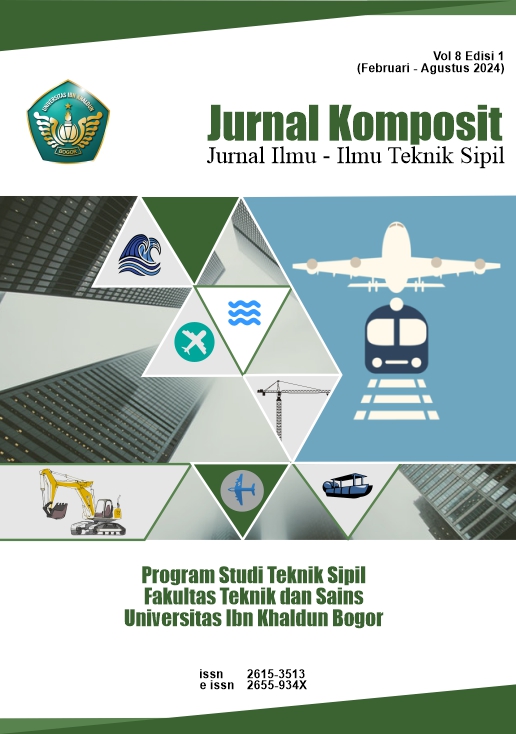Pengaruh Penerapan Kebijakan Low Emission Zone terhadap Perubahan Perilaku Perjalanan Komuter di Kawasan Kotatua Jakarta
DOI:
https://doi.org/10.32832/komposit.v8i1.14718Keywords:
Low Emission Zone, Binary Logit, mode preference, Transport Demand ManagementAbstract
Along with the increasing population growth of DKI Jakarta, the need for transportation services is also increasing. This has resulted in a growth in the number of motorized vehicles, the high number of private vehicles in DKI Jakarta causes many transportation problems as well as will increase the number of air pollutants that can pollute the air and have a negative impact on the environment and air quality, one of the government policies that began to be implemented to reduce the use of private vehicles while reducing air pollution is the implementation of the Low Emission Zone (LEZ) policy in Kotatua Jakarta, with this policy with this policy, it is expected that people will reduce the use of private vehicles and shifting to public transportation.
This study aims to determine the effect of the implementation of the LEZ policy on changes in travel behavior and identify factors that influence mode selection preferences using the binary logit regression method, after the implementation of the LEZ policy there are a change in commuter travel behavior in including the percentage of respondents from West Jakarta increased by 7%, the dominant shift in modes used by respondents from private vehicles to Public transportation as 21.42%, it was also seen that the use of private vehicles such as motorcycles and private cars decreased from 62.14% to 42.85%, there was a decrease in travel costs and an increase in travel time while factors that influenced the choice of mode preferences included education level, income, travel patterns and travel costs.
Keyword : binary logit, Low Emission Zone, mode preference
References
Argarisma, A., & Naipospos, B. P. (2023). Peningkatan Penggunaan Moda Non-Motorized Transport dengan Stated Preference pada Pelajar Sekolah Menengah Negeri Jakarta Pusat. Jurnal Komposit: Jurnal Ilmu-Ilmu Teknik Sipil, 7(2), 183–191. https://doi.org/10.32832/komposit.v7i2.14520
Cass, N., Faulconbridge, J. (2016). Commuting Practices: New Insights into Modal Shift from Theories of Social Practice. Transport Policy 45, 1-14. https://doi.org/10.1016/j.tranpol.2015.08.002
Creswell, J. W. (2009). Research Design: Qualitative, Quantitative, and Mixed Methods Approaches (3rd ed.). Sage Publications, Inc.
Broaddus, A. (2010). Pelayanan Konsultasi Kebijakan Transportasi. Eschborn:GTZ CAF.2014. Edinburghtrams.
Dell’Olio, L., Ibeas, A., Cecín, P. (2010). Modelling User Perception of Bus Transit Quality. Transport Policy (2010) 17(6) 388-397. https://doi.org/10.1016/j.tranpol.2010.04.006
Hosmer, D., Lemeshow, S. (2000). Applied Logistic Regression, Hoboken, New Jersey: John Wiley & Sons, Inc.
Manheim, M. L. (1979). Fundamentals of Transportation System Analysis, Volume 1, Basic Concept. The MIT Press: Cambridge.
Meyer, M. D., & Miller, E. J. (2001). Urban transportation planning: A decision- oriented approach. Boston: McGraw-Hill.
Ortúzar, J,. Willumsen, L. (2011). Modelling Transport. New Jersey: John Wiley & Sons.
Piras, F., Sottile, E., et.al. (2022). Does the Joint Implementation of Hard and Soft Transportation Policies Lead to Travel Behavior Change? An Experimental Analysis. Research in Transportation Economics, 95, 101233. https://doi.org/10.1016/j.retrec.2022.101233
Sugiyono, S. (2016). Metode Penelitian Kuantitatif, Kualitatif dan R&D. Bandung: Alfabeta.
Tamin, O. Z. (1997), Perencanaan dan Pemodelan Transportasi, Bandung: ITB.
Tarriño-Ortiz. J., Gómez, J., et.al. (2022). Analyzing the Impact of Low Emission Zones on Modal Shift. Sustainable Cities and Society, 77, 103562. https://doi.org/10.1016/j.scs.2021.103562
Tögel, M., Špička, L. (2014). Low-Emission Zones in European Countries. Transactions on Transport Sciences, 7(3) 97-108. DOI:10.2478/trans-2014-0007
Downloads
Published
How to Cite
Issue
Section
License
Copyright (c) 2024 Jurnal Komposit: Jurnal Ilmu-ilmu Teknik Sipil

This work is licensed under a Creative Commons Attribution-NonCommercial-ShareAlike 4.0 International License.
Authors who publish with this journal agree to the following terms (Penulis yang mengajukan publikasi artikel telah menyetujui hal berikut):
- Through this publication, the author agree to submit the copyright of article writing to Jurnal Komposit: Jurnal Ilmu-ilmu Teknik Sipil. This copyright submission takes the form of, but is not limited to: reproduction of the article and parts therein, including photographic reproductions; distribution of articles through printed and electronic documents; and translation of articles(Bahwa melalui publikasi ini, hak cipta penulisan artikel diserahkan kepada Jurnal Komposit: Jurnal Ilmu-ilmu Teknik Sipil. Penyerahan hak cipta ini berupa, namun tidak terbatas pada: perbanyakan artikel dan bagian di dalamnya, termasuk reproduksi fotografi; penyebarluasan artikel melalui dokumen cetak dan elektronik; serta penterjemahan artikel).
- The authors agree to the terms of the Copyright Notice, according to Creative Commons Attribution-NonCommercial-ShareAlike 4.0 International License., which will apply to this article if and when it is published by Jurnal Komposit: Jurnal Ilmu-ilmu Teknik Sipil. (Para penulis setuju dengan ketentuan Pemberitahuan Hak Cipta, sesuai dengan Lisensi Internasional Creative Commons Attribution-NonCommercial-ShareAlike 4.0., yang akan berlaku untuk artikel ini jika dan ketika diterbitkan oleh Jurnal Komposit: Jurnal Ilmu-ilmu Teknik Sipil).

This work is licensed under a Creative Commons Attribution-NonCommercial-ShareAlike 4.0 International License.



.png)










